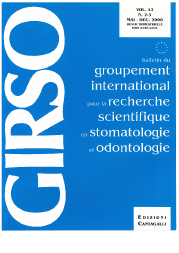Orthodontic appliances in the treatment of sleep apnea: a cephalometric and polysomnographic study (Article in French)
Abstract
AIM: Effects of oral appliances on snoring in patients with obstructive sleep apnoea syndrome: correlation between cephalometry with and without oral appliance (OA) in place. SUBJECTS: 15 patients were treated with 3 types of OA: Herbst, tooth positioner and QuietKnight. METHODS: All patients underwent a full-night diagnostic polysomnography. They were asked to use their OA each night during one month. All the subjects then underwent a second polysomnography with the OA in place. Standard cephalometric analysis was done in each patient with and without the OA in place. RESULTS: Although average apnea-hypopnea index decreased significantly, snoring was not affected by the OA. Only in 7 patients a reduction was observed. There was a strong correlation between the change in snoring index during sleep and 2 cephalometric variables: ANB angle without, and overjet with the OA in place. No change in quality of sleep was observed. CONCLUSION: OA are indeed effective in decreasing the number of obstructive apneas and hypopneas, without affecting the quality of sleep. Snoring reduction with OA may be predicted by cephalometry.
Downloads
Published
Issue
Section
License
I hereby certify that the authors of the above manuscript have all:
1. Conceived, planned, and performed the work leading to the report, or interpreted the evidence presented, or both;
2. Written the report or reviewed successive versions and shared in their revisions; and
3. Approved the final version.
Further, I certify that:
1. This work has not been published elsewhere and is not under revision in another journal;
2. Humane procedures have been followed in the treatment of experimental animals (if applicable);
3. Investigations in humans was done in accordance with the ethical standards of the responsible committee on human experimentation or with the Helsinki Declaration (if applicable).
4. This paper has been carefully read by a native English speaker who is familiar with the field of work (this applies to authors who are not fluent in English); and
5. The copyright of the article is transferred from the authors to the Bulletin du Groupement International pour la Recherche Scientifique en Stomatologie et Odontologie upon acceptance of the manuscript.



